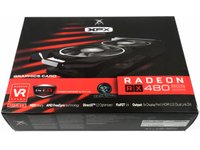
With the XFX RX480 GTR Black Edition (BE) we are now testing a card that is almost identical to the HIS RX480 IceQ X2 Roaring Turbo. The biggest difference is in the radiator cover and the installed fans, as well as a slightly different firmware.
Both companies are brands of Pine as a conzer nut, so a double recycling of the board and components is of course obvious, because it simplifies the purchase (quantity) and the production (production processes) immensely. Nevertheless, both cards are quite different in the end, even if they both share a greedy error. But more on that later.
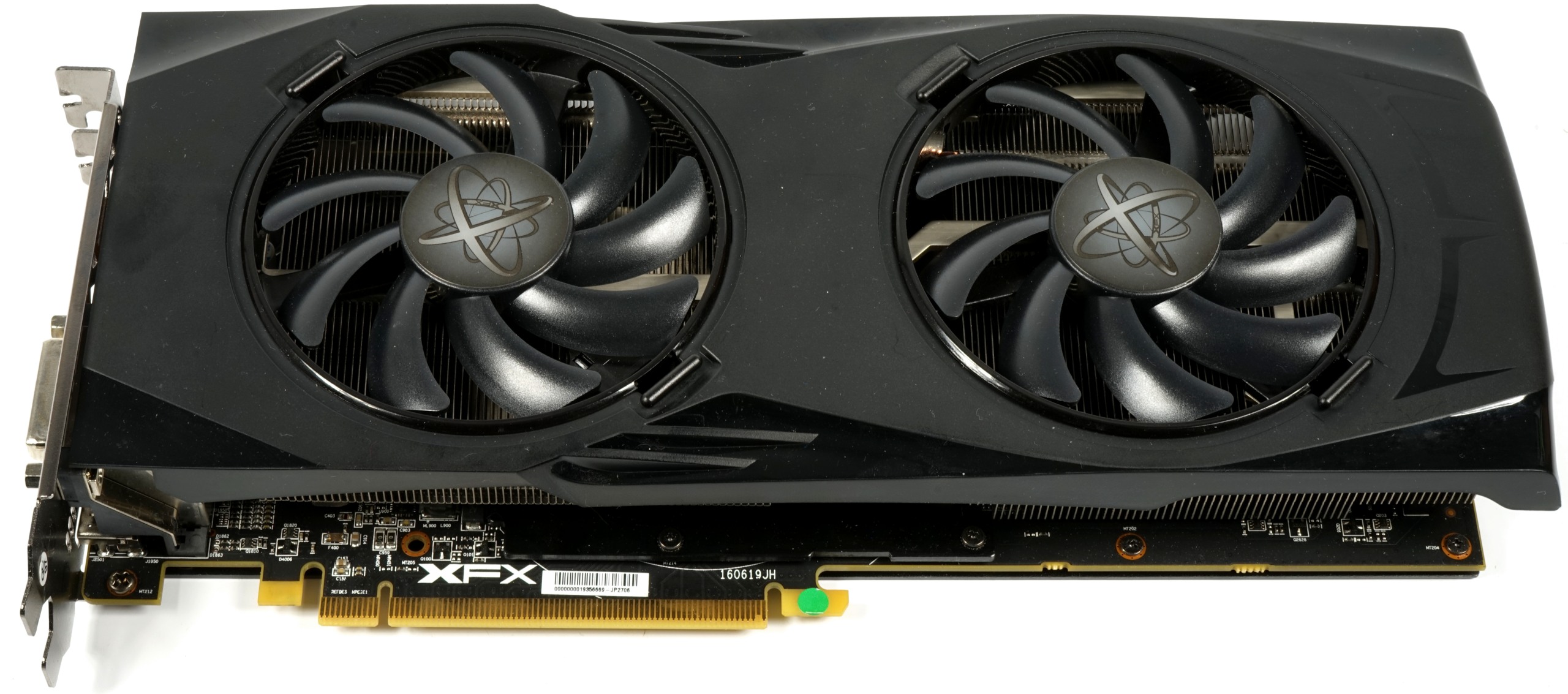
1. External appearance and key data
At 937 grams, the card is not a real lightweight, but still remains well below one kilo. With a maximum installation length of 28 mm (slot panel outside to rear edge radiator cover), a mounting height of 12.5 cm (upper edge slot to top edge radiator cover), and a mounting depth of 3.5 cm, it is a true dual slot card.
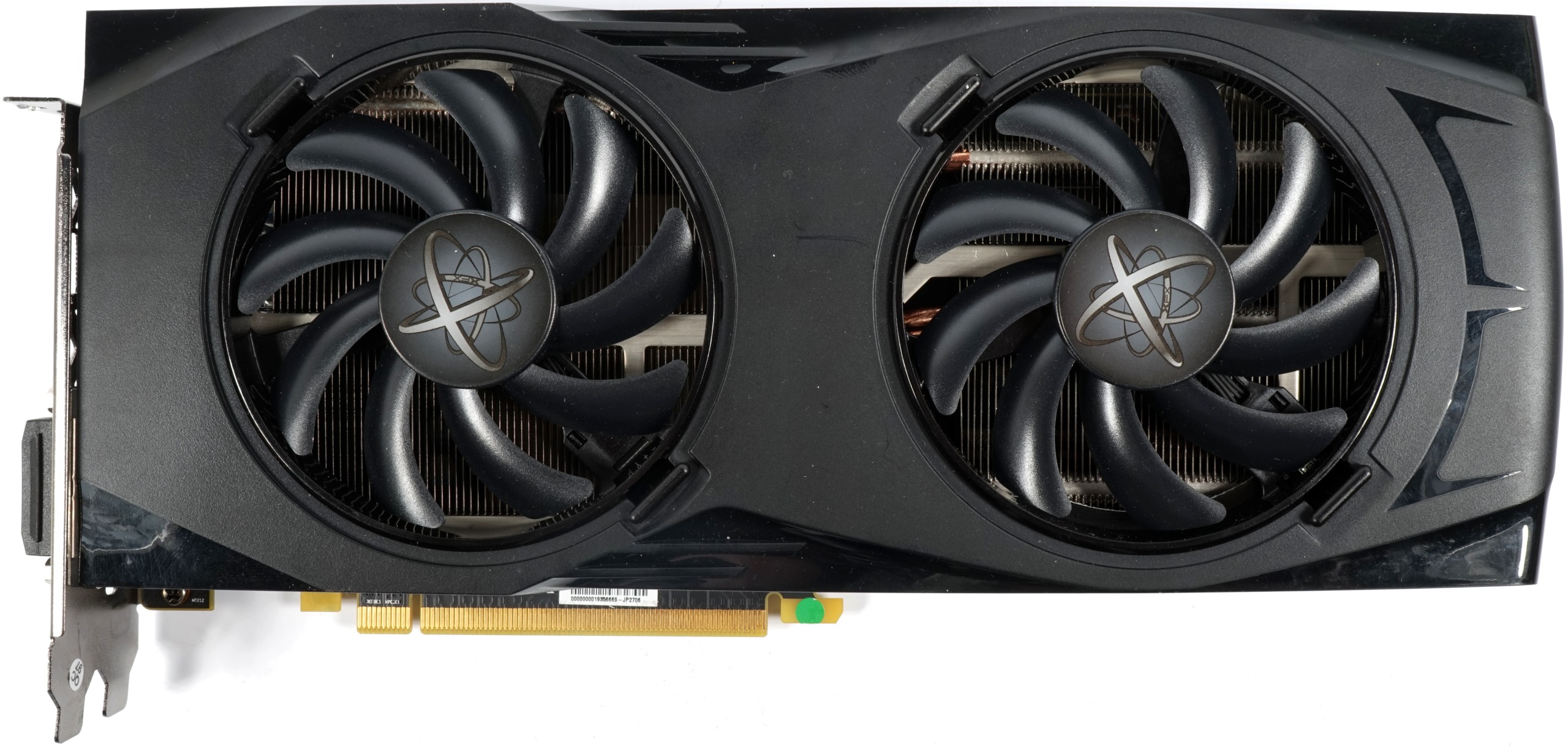 |
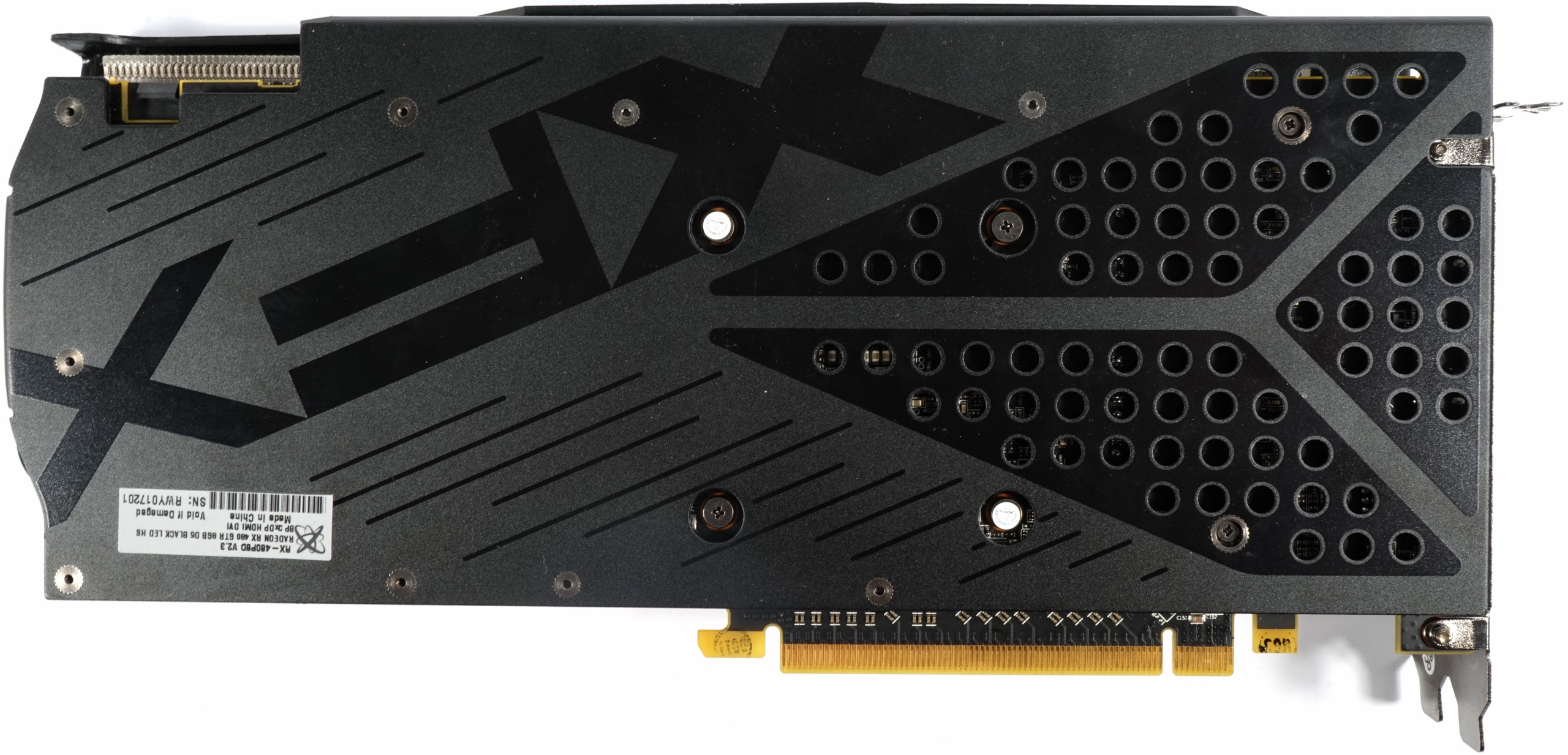 |
The backplate also requires a further 0.5 cm of installation depth on the back, which must be taken into account in ITX projects and CPU tower coolers. From a purely visual lynot, the map is rather a dreary matter made of black plastic, but this can be mitigated somewhat by the exchange of modules illuminated in other colours.
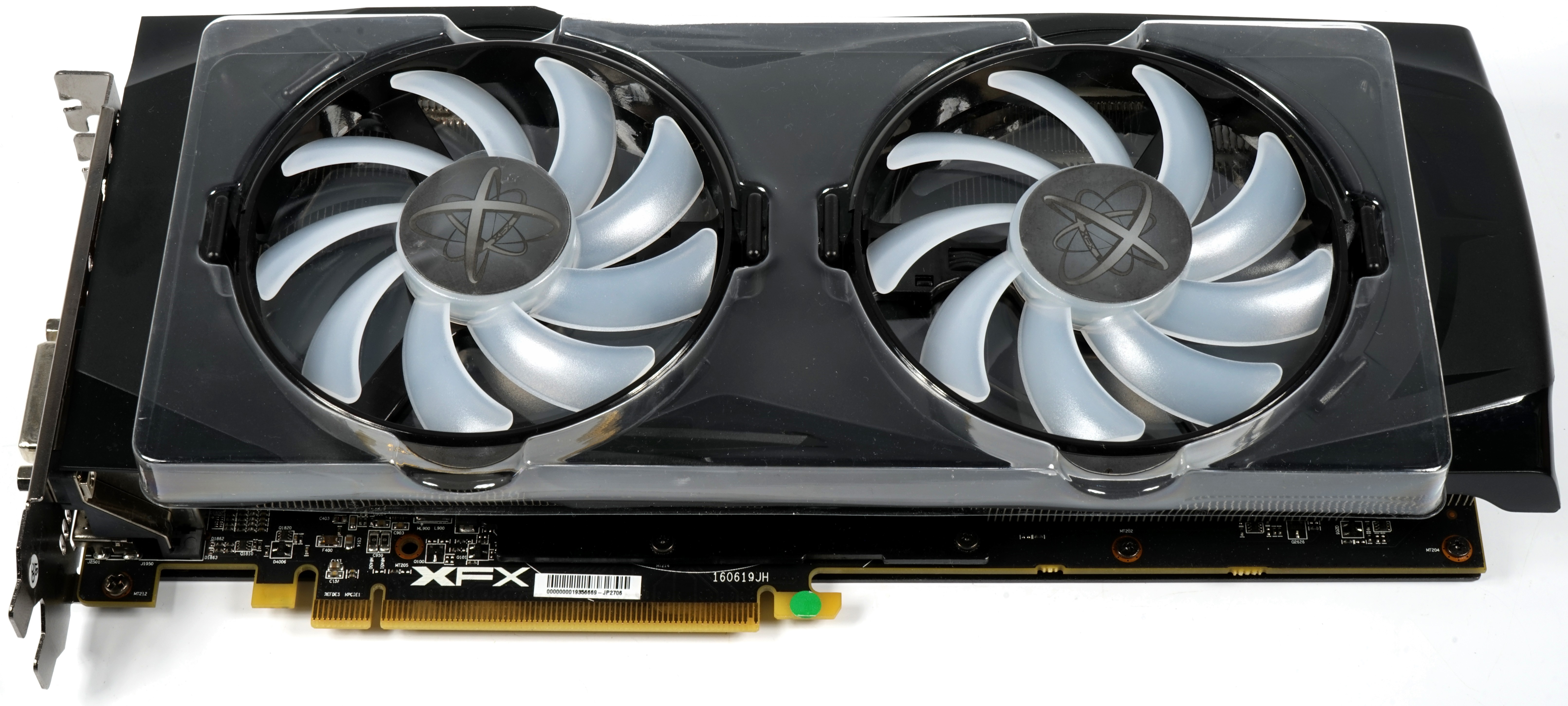
The slat orientation is unfortunately vertical, which significantly heats the motherboard below the cards and does not help to transport any warm exhaust air at the end of the card. At the top, an illuminated XFX logo and the 8-pin PCIe power supply connector dominate the image.
 |
 |
The end of the card shows us three of the four 6 mm heatpipes. The slot panel is equipped as standard in class and carries a DVI-D connector, three connectors for the DisplayPort 1.4 and an HDMI 2.0 output in addition to an air opening stylized as the XFX logo. In between there are other small air openings, which have a rather decorative character.
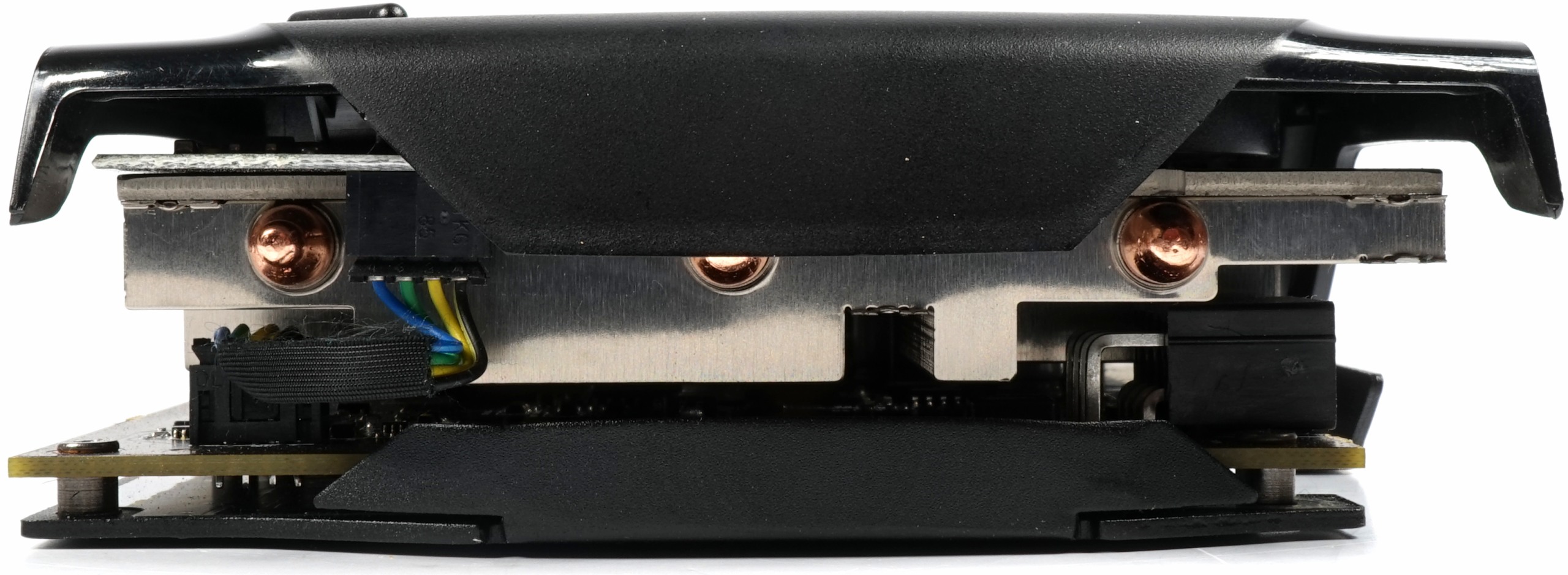 |
 |
2. Board layout and power supply
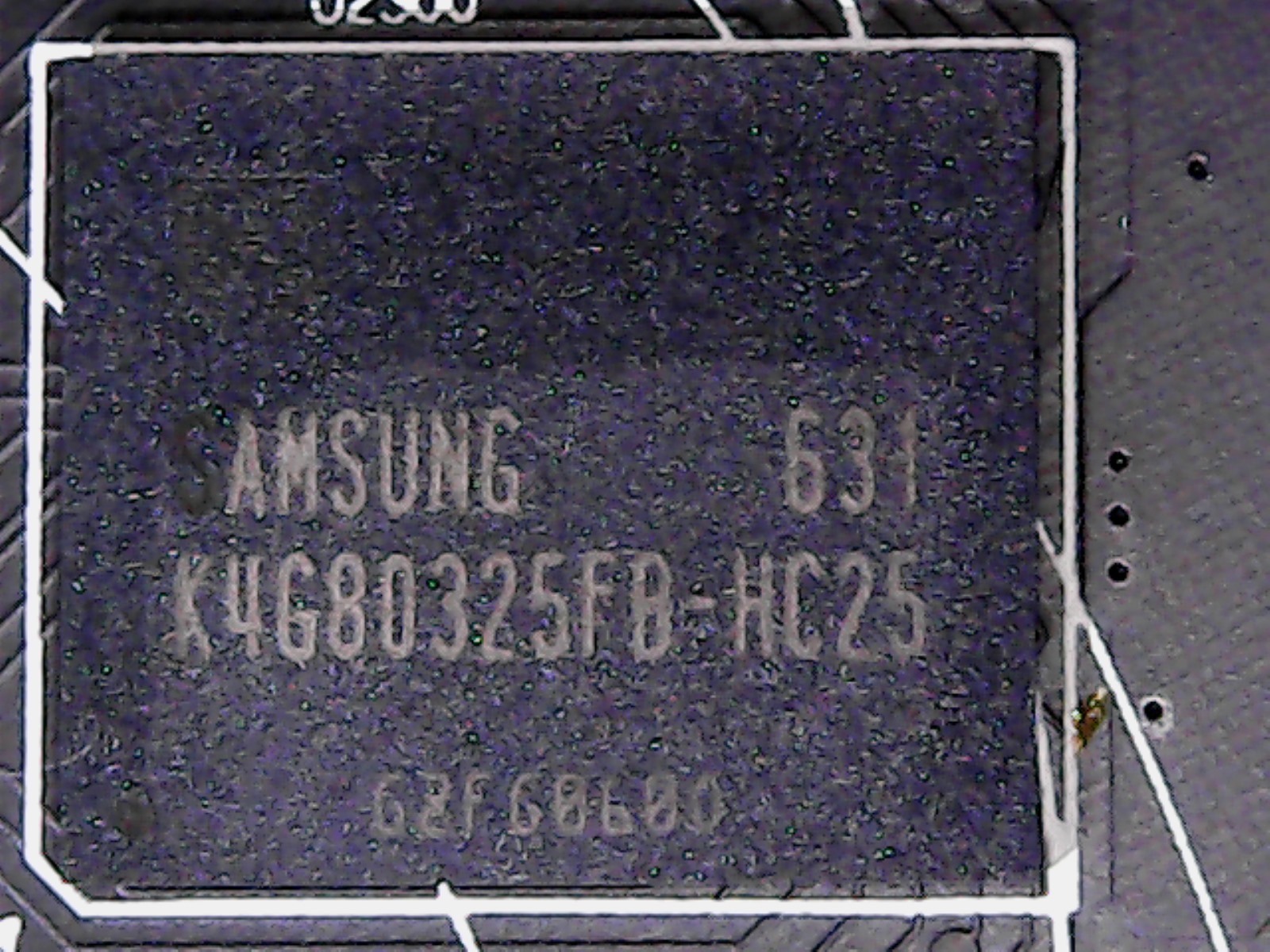 If we remove the backplate and the cooler, we can take a look at the board. XFX has left it to the left when positioning the GPU and is therefore more orientated towards the reference layout. The overlong board therefore shows on the other side, in addition to the other larger voltage converter blocks, a rather wide-ranging component assembly, whereby the board could have been significantly shorter without need.
If we remove the backplate and the cooler, we can take a look at the board. XFX has left it to the left when positioning the GPU and is therefore more orientated towards the reference layout. The overlong board therefore shows on the other side, in addition to the other larger voltage converter blocks, a rather wide-ranging component assembly, whereby the board could have been significantly shorter without need.
In terms of memory, XFX, like the reference, uses the K4G80325FB HC25 to set eight 1GB DDR5 modules from Samsung. This consumer memory is specified for operating temperatures of up to 85°C and is operated on this card with 2000 MHz.
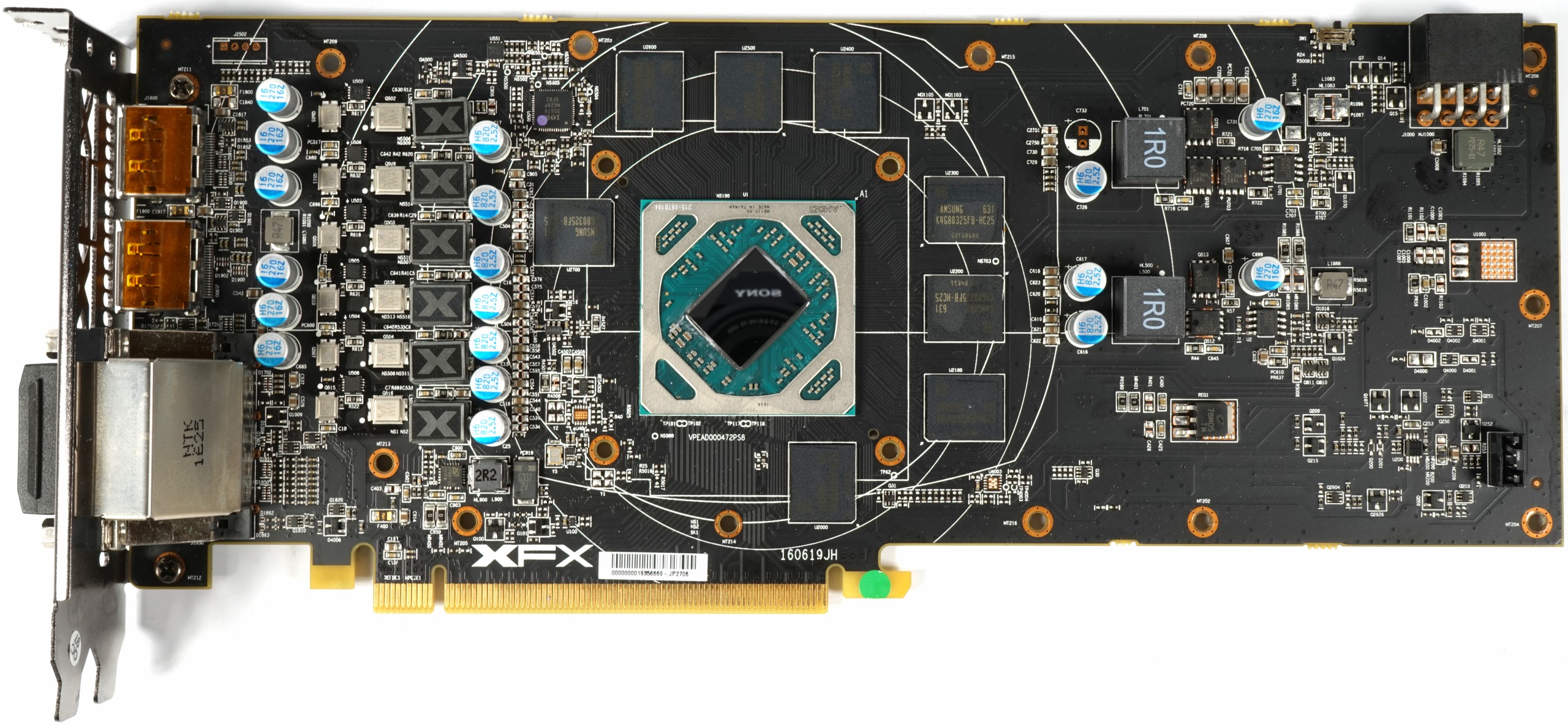 |
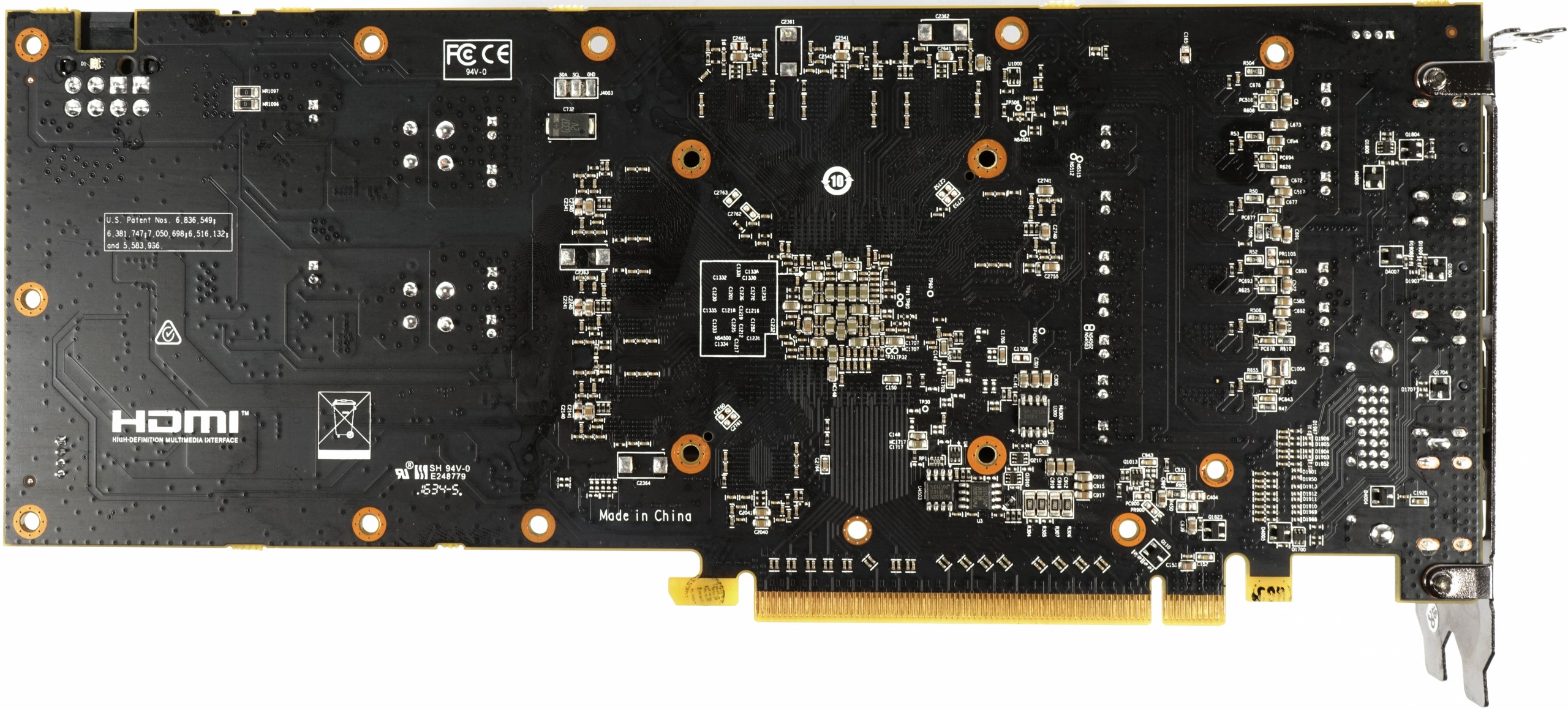 |
The GPU relies on six individual phases provided by an IR 3567 from International Rectifier. The connection to the controller chip is generated at each phase via a CHL 8510 as a gate driver, which controls the relevant MOSFETs of the control circuit.
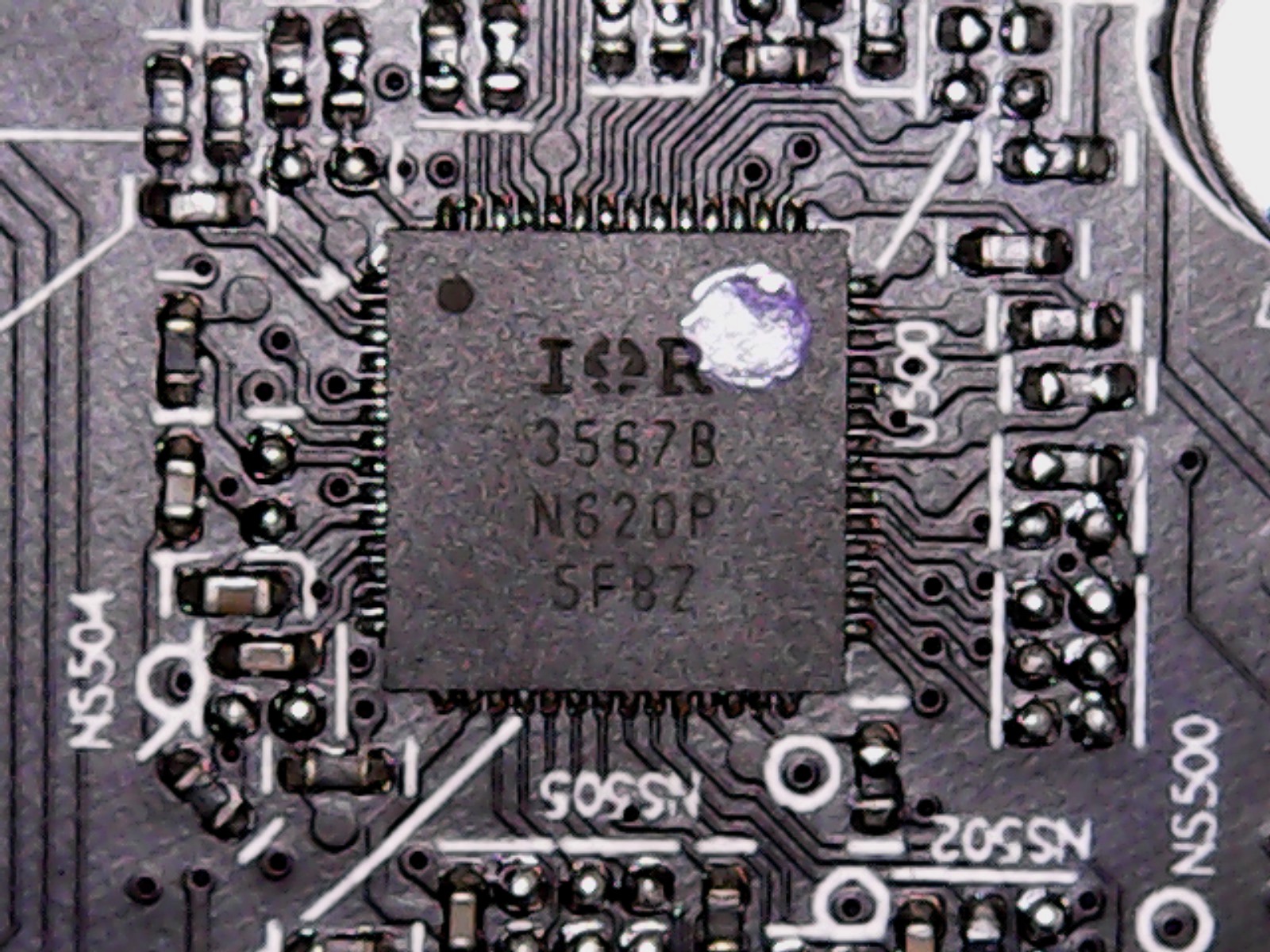 |
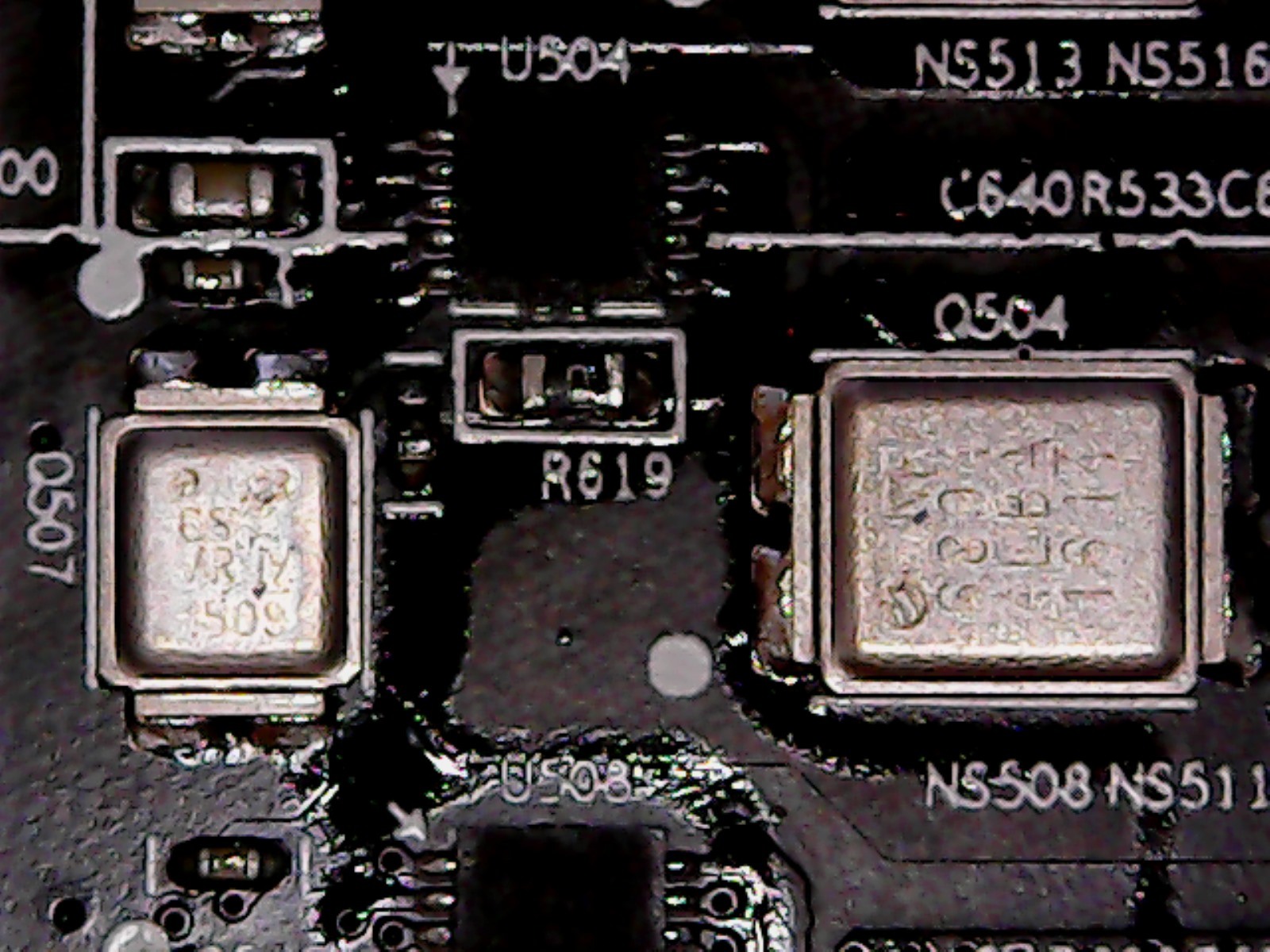 |
The actual tension conversion then takes place on the high-side via an IRD 6811 and on the low-side via an IRF 6894. The advantage of the MOSFETs in the metal package is the significantly better coolability, however, the housings are not insulated, so you have to pay attention to possible short circuits when cooling.
The coils used are based on normal, encapsulated ferrite coils, which were shed in a thin-walled case and decorated with an X in contrast to the sister of HIS. The quality should also be rated as rather average, because vibrations are quite audible and measurable as a subtle snoring.
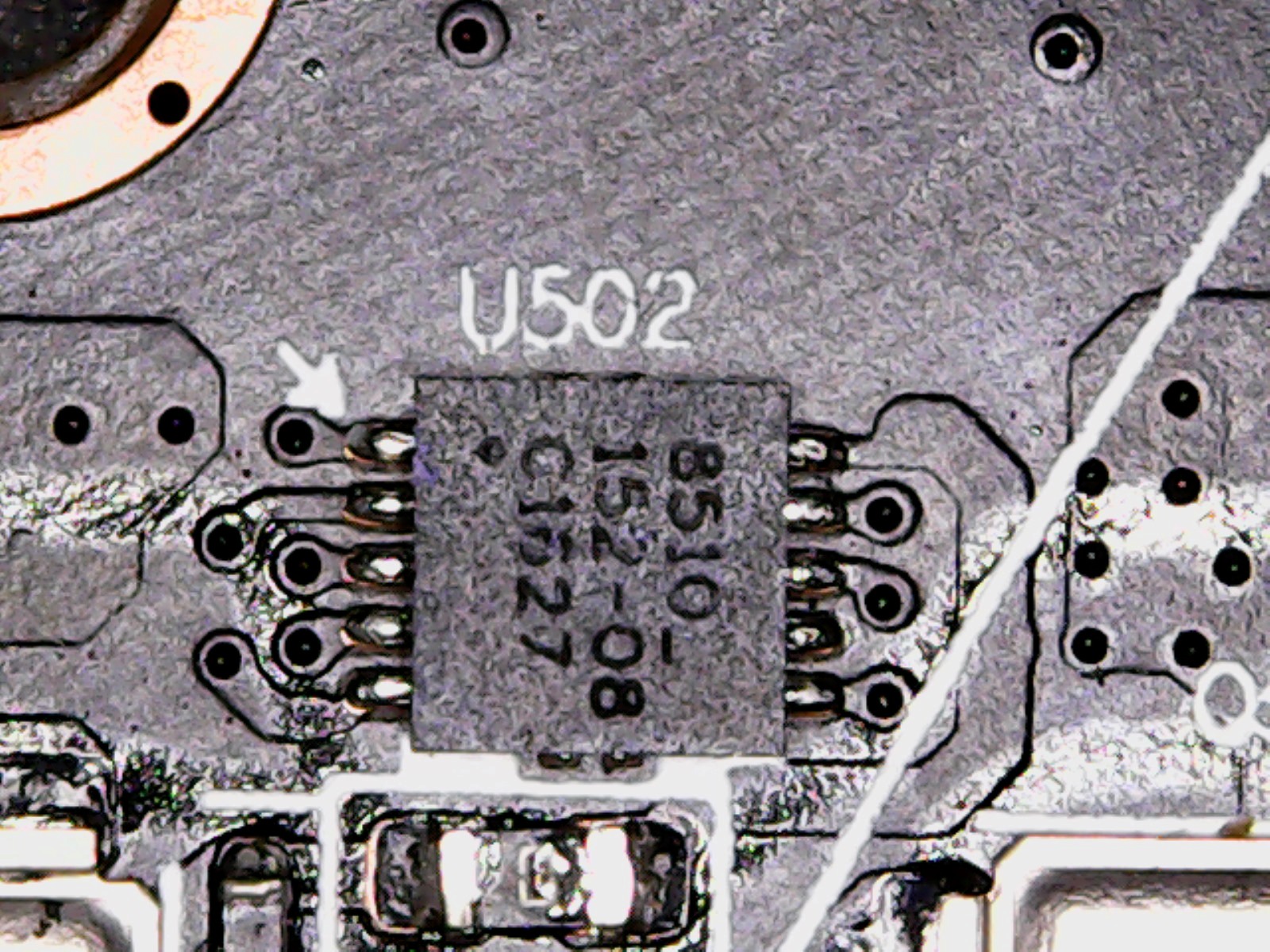 |
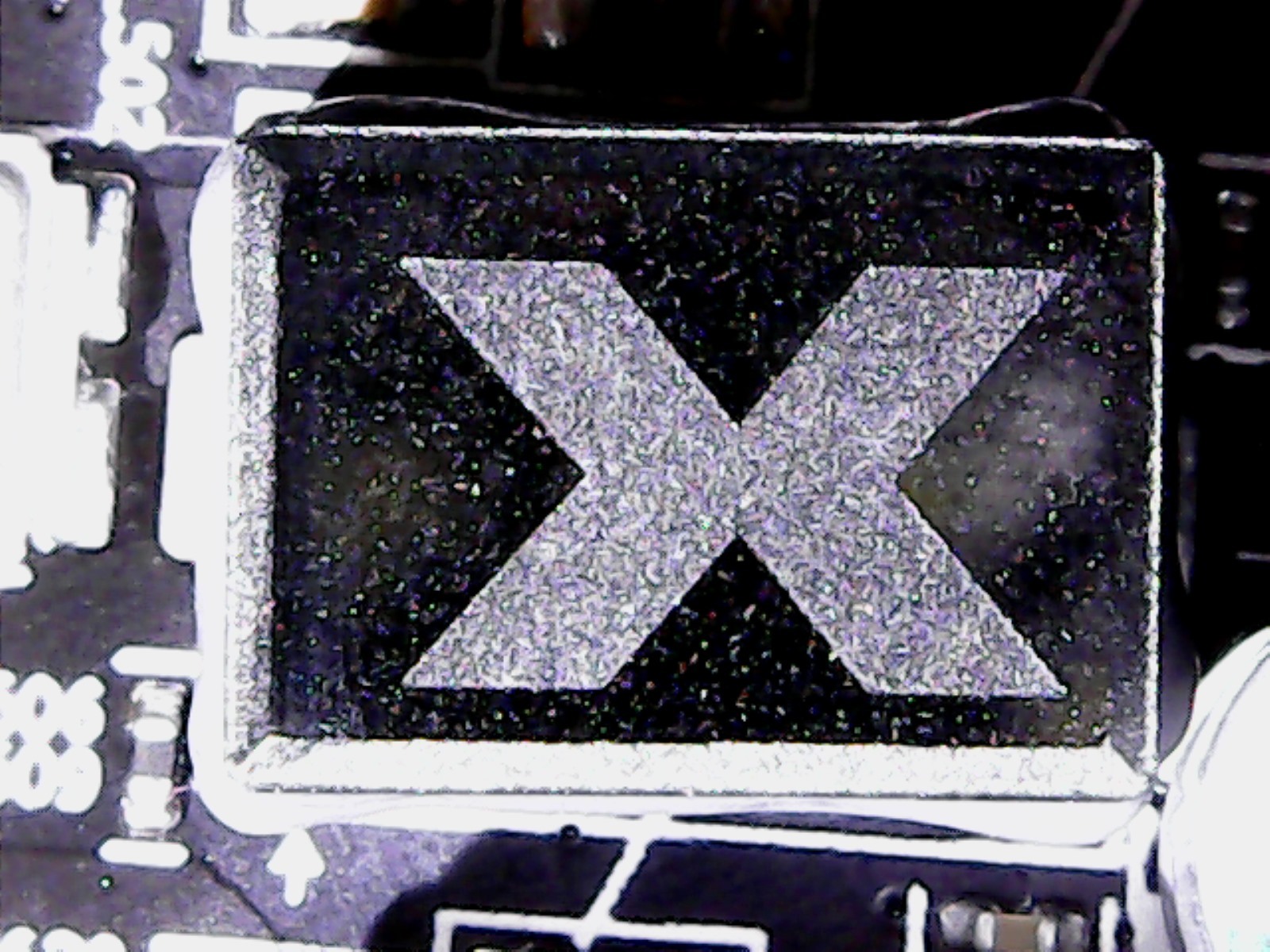 |
The VR for memory relies on a more conservative solution, whereby a phase on the right side of the board must suffice. A second voltage converter, which at first glance is similarly designed, then supplies the peripherals and the controllers. With the APW 8722, these two voltage converters are each based on a simple buck controller, which drives an SM4377 on the high-side, as well as two SM4373s on the low-side, all three of which come from Sinopower as well as the Buck controller.
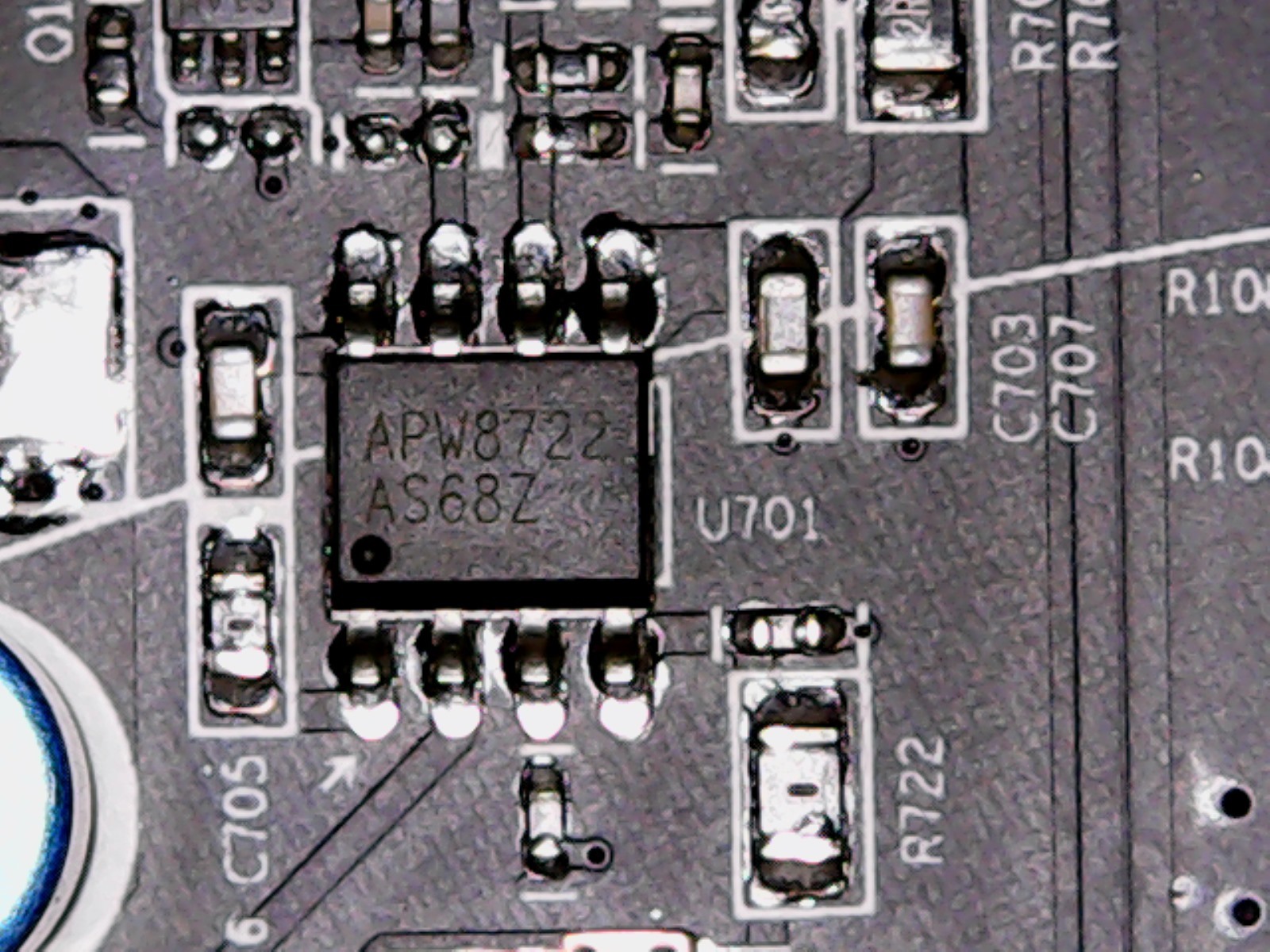 |
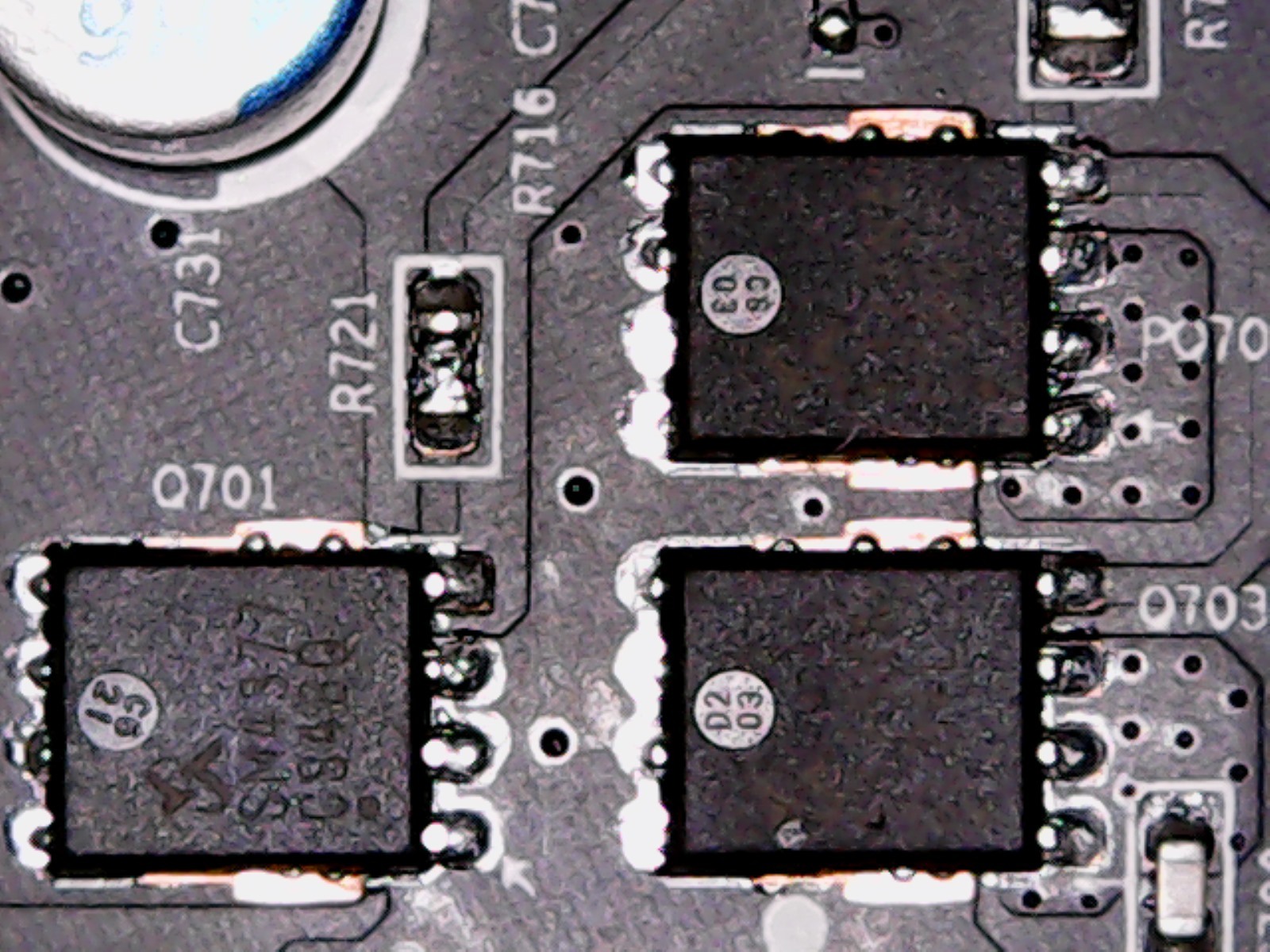 |
3. Power consumption and compliance
The power consumption of this factory overclocked map is far above what we could measure for the reference design. The 19 watts in the idle are actually no longer up-to-date, but are due to the generously sized voltages and the high idle clock of at least 300 MHz.
In the gaming loop, the card reaches almost 190 watts and is thus already 25 to 30 watts above the reference card, while the Torture loop then measured 212 watts. We see that XFX sets both RX480 GTR BE to a slightly different, slightly more moderate design of the power limit than HIS. Nevertheless, both cards are about the same speed.
Much more is not possible, whereby the peak values represent only short moment values, which do not have to be used as a guideline for the power supply measurement, but show that one should pay attention to a qualitatively appropriately equipped secondary side of the power supply (low Impedance Caps).
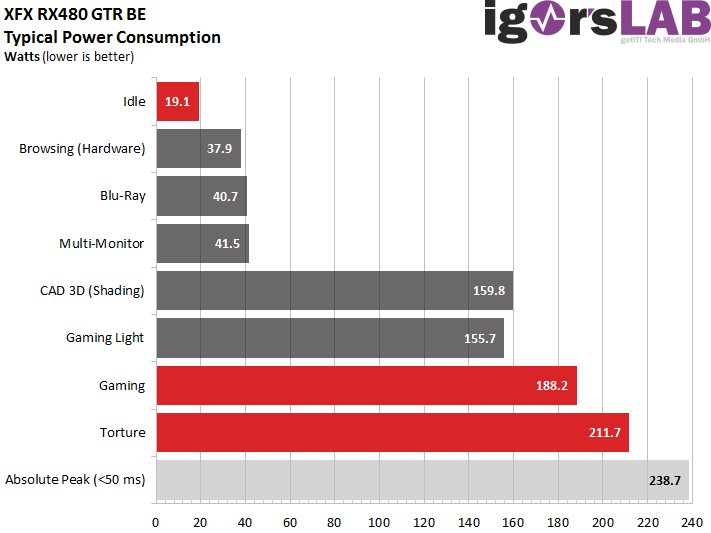
The two graphs that follow illustrate the course over 2 minutes each in the gaming loop and in the Torture test, on which the respective calculation of the average power consumption is based.
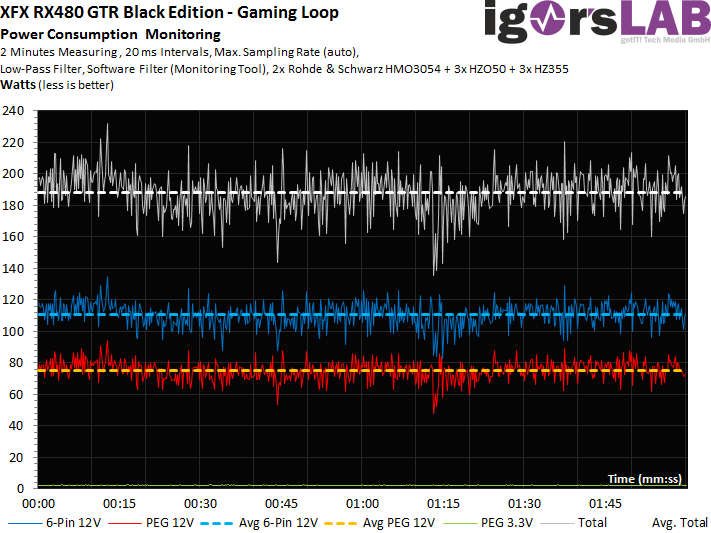 |
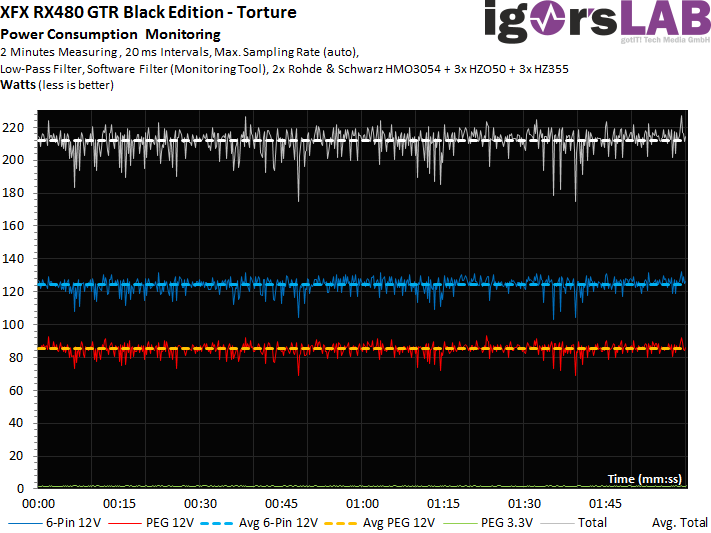 |
Let's now turn to the evaluation of the flowing currents and they (unfortunately) really have it in them. First, we can take a look at the current flows of the individual supply rails corresponding to the diagrams above.
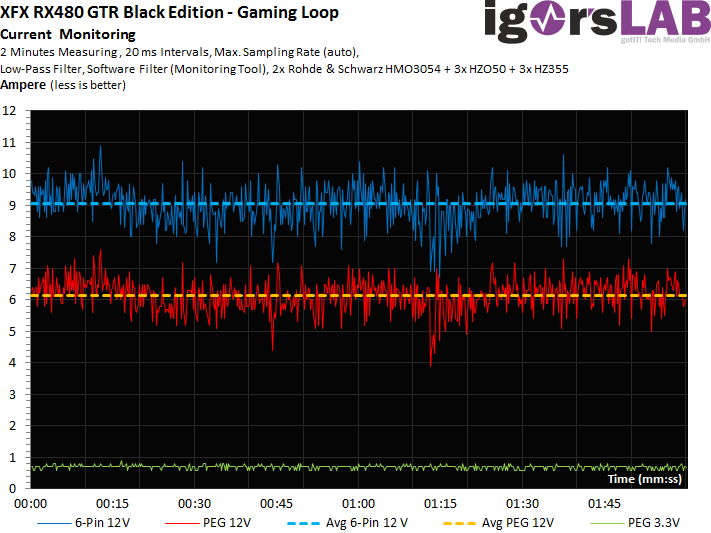 |
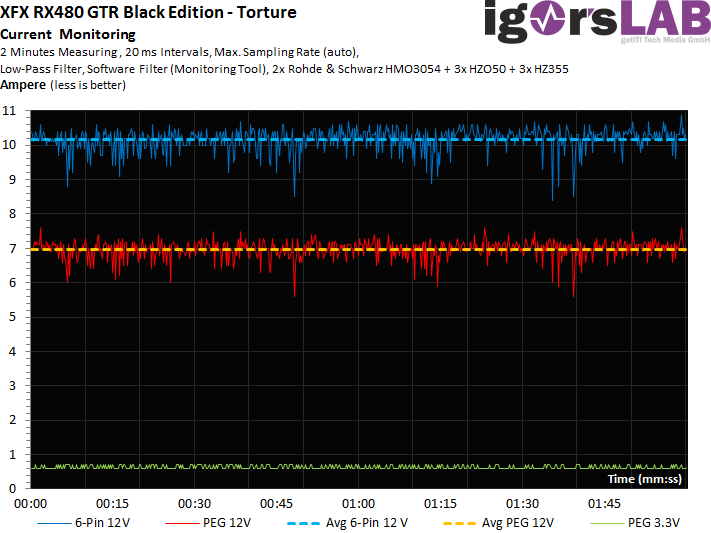 |
What we see definitely cannot please in this form. If we remember the launch article for the Radeon RX480, it was precisely the non-standard load on the 12V motherboard connector that caused AMD to have to improve by means of a driver trick. But what we had to measure with this map clearly eclipses this imbalance!
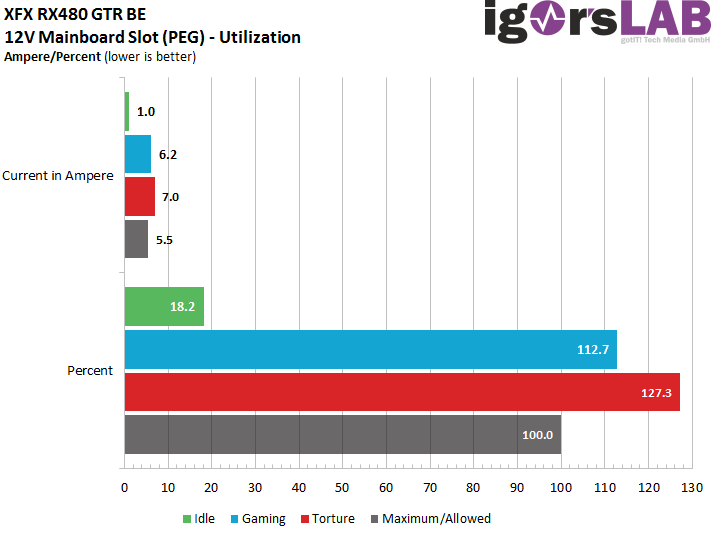
With a whopping 7 amps, the card exceeds the maximum current on this rail on the motherboard set by the PCI SIG to 5.5 amps by just over 27%! Even if current mainboards with the fourth connection, which is actually designated as a reserve pin, can better split the current flow, this card is definitely not recommended for upgraders without a precise knowledge of the installed hardware.
4th. Cooler structure and temperatures
The cooling concept is simple and conservative. XFX relies on a backplate insulated inside with foil, which has not been included in the cooling concept and serves only for stabilization and optics.
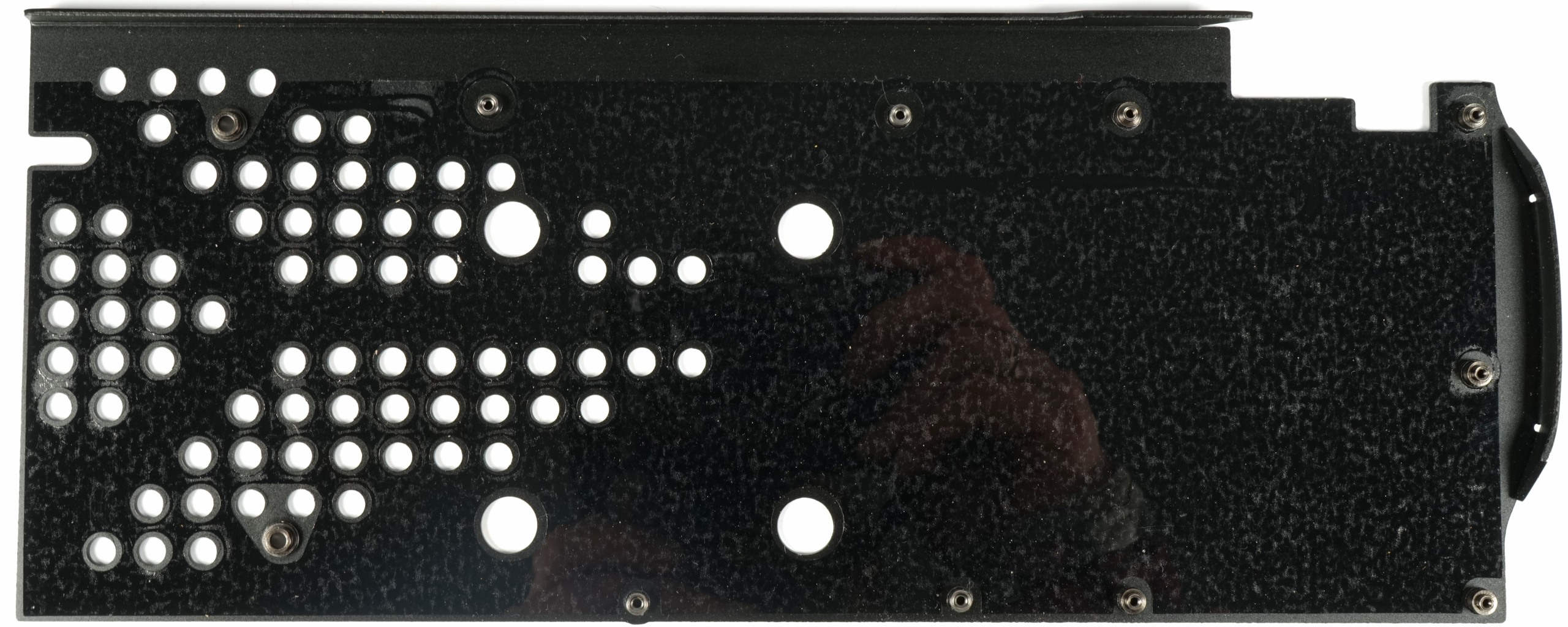
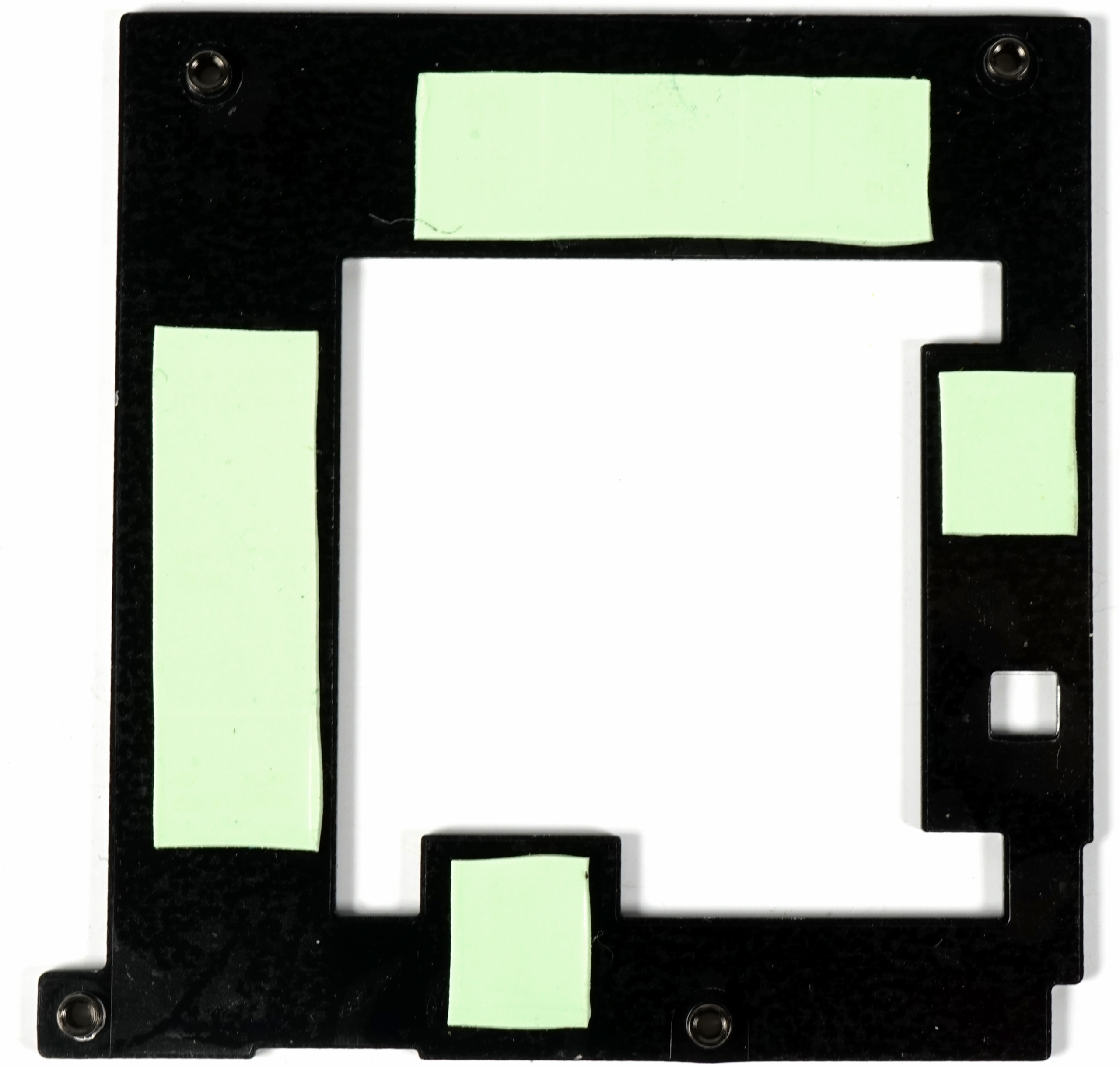
The storage is not cooled via the heat sink, but a separate, smaller cooling frame below the actual cooler. Whether and how the concept works in this way, we will see in a while.
The cooler itself consists of a copper heat sink for the GPU, in which a total of four 6mm heatpipes were pressed, which are made of sintered composite material and in which no nickel plating has been used.
While the heat sink on the back is firmly connected to one part of the slat cooler via a plate and is supported by a curved heatpipe, the other three heatpipes transport the waste heat towards the end of the map.
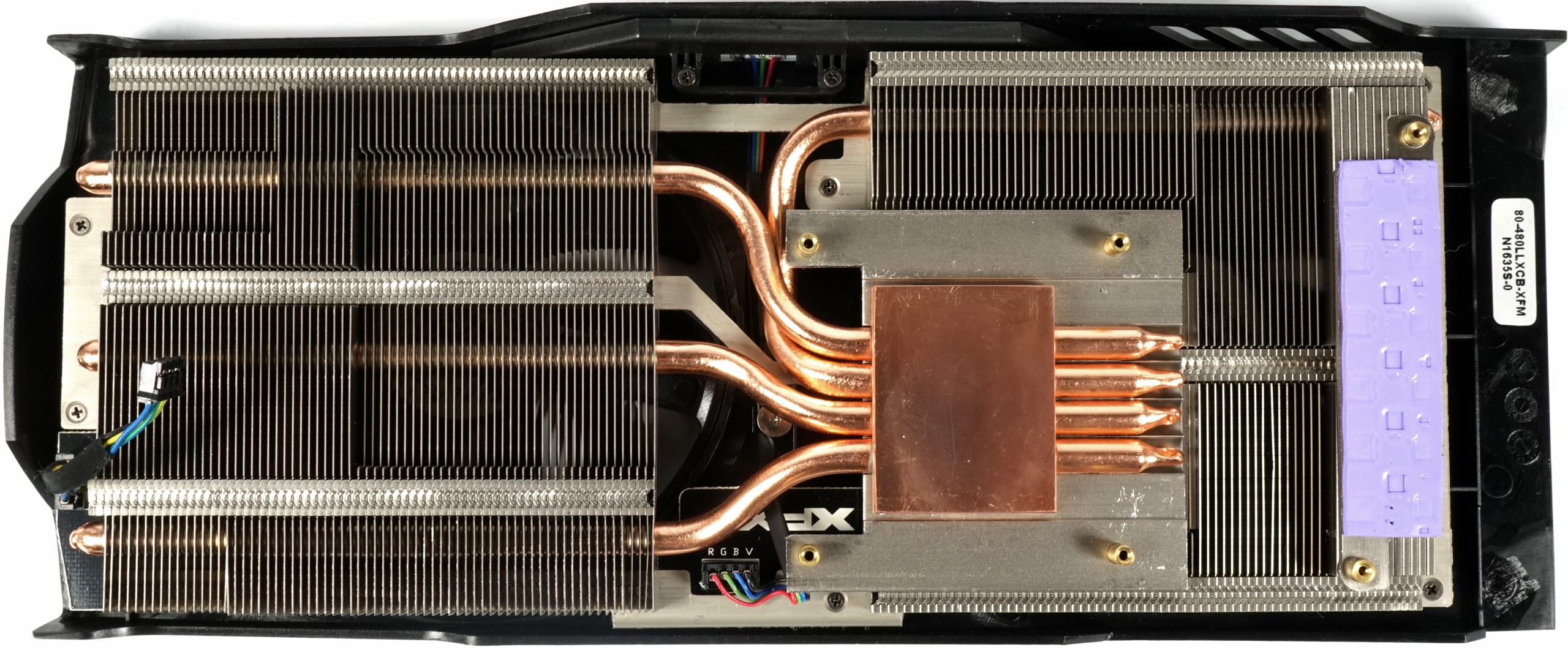
The cooling performance is quite neat, because in the gaming loop the maximum clock of 1338 MHz is kept quite constant and only sporadically breaks down by a few MHz. The reasons for this are due to the very high power limit, which only begins to take effect in some places at very high load (torture).
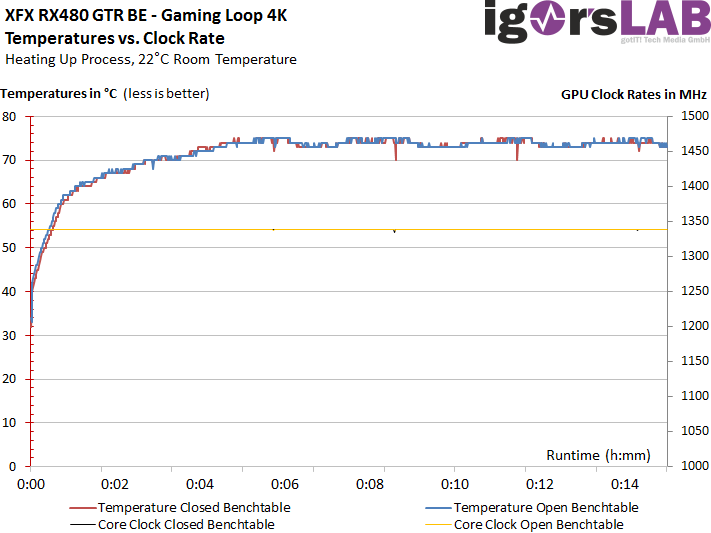 |
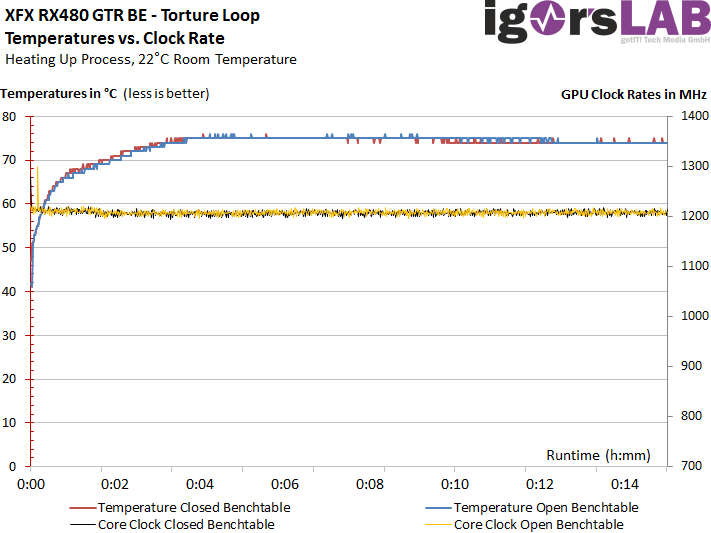 |
Let us now consider the temperatures not as a curve, but check what consequences the load leaves on the board. With just under 73°C in an open structure and a little more than 73°C in the closed housing, the voltage converters are about the same hot as CPU, which also brings it to just under 73°C.
The memory is in the middle of the warmest module, so that here at approx. 80°C everything is still in balance, even if it is already the limit of 85°C specified in the specs for the memory.
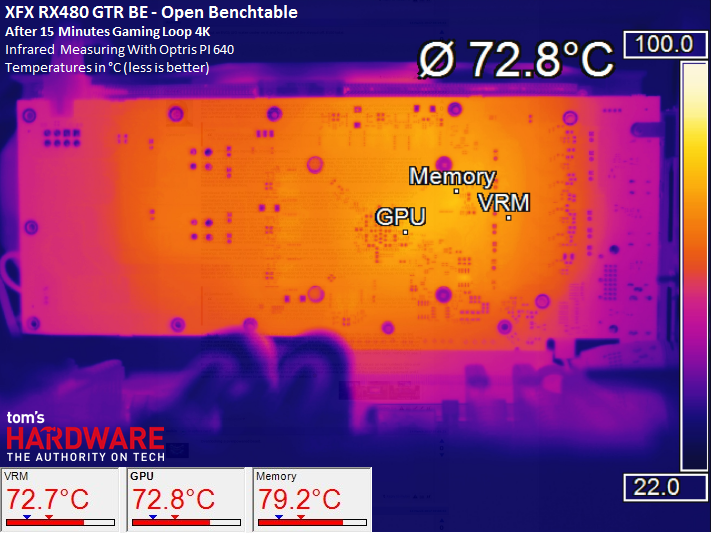 |
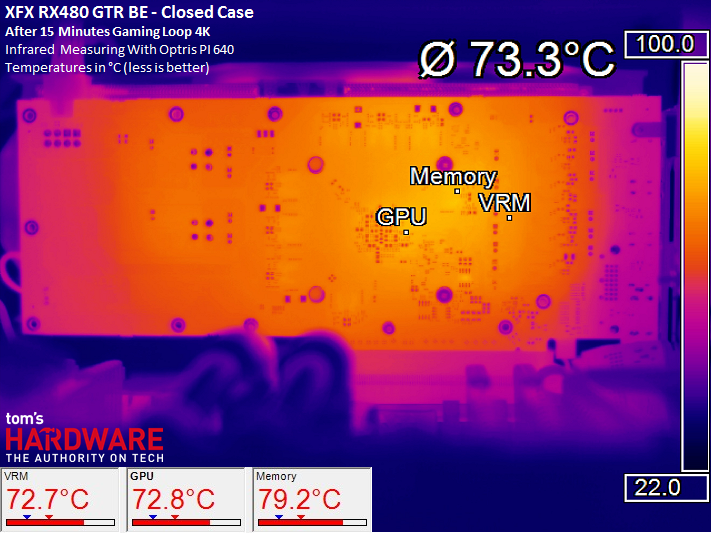 |
In the stress test, we measure 76°C for the voltage converters. The CPU is still well in the race with a plentiful 76°C in the open setup. In the closed structure, we can see that the coolers are already turning so high that the board on the base is connected to approx. 77°C only becomes imperceptibly hotter. What cannot please, however, is that the memory is already operated just below the maximum temperature specified by the manufacturer. There is hardly any air up here in summer.
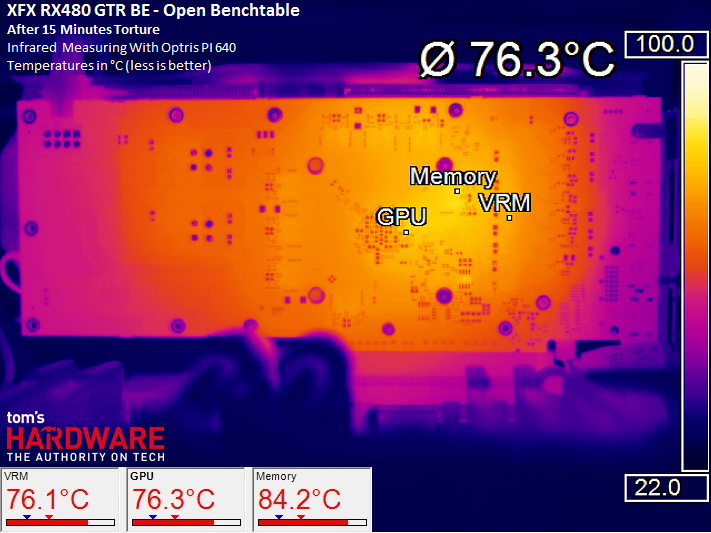 |
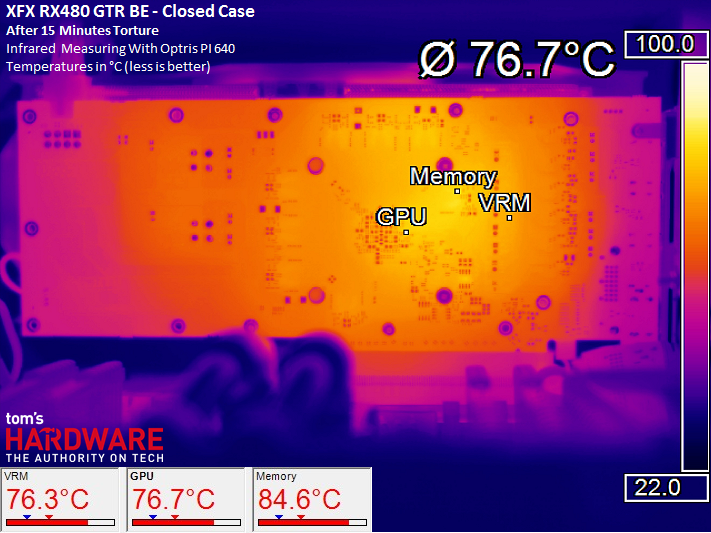 |
The cooling is therefore also reasonably acceptable in the closed housing, even if the lower operating noise is purchased here by significantly higher temperatures than on the HIS card. Which would have given us an elegant transition.
5. Fan speeds and noise emission
So what do the fans have to do to reach these temperatures? Due to the rotor geometry and the number of blades, the two 92mm fans are designed for throughput rather than static pressure, although the radiator fins are quite tight. But the result may well come as a surprise, which also suggests that the Airflow on the XFX card is much more concentrated due to the use of fan rings than with the simple and large holes of the HIS sister card.
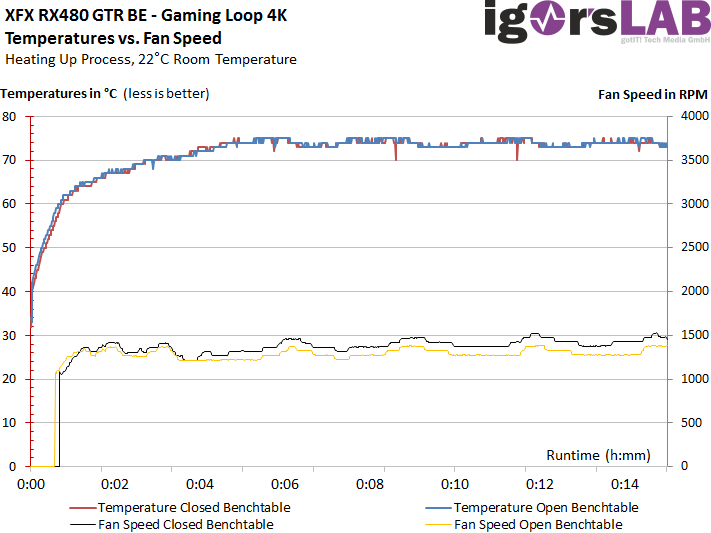 |
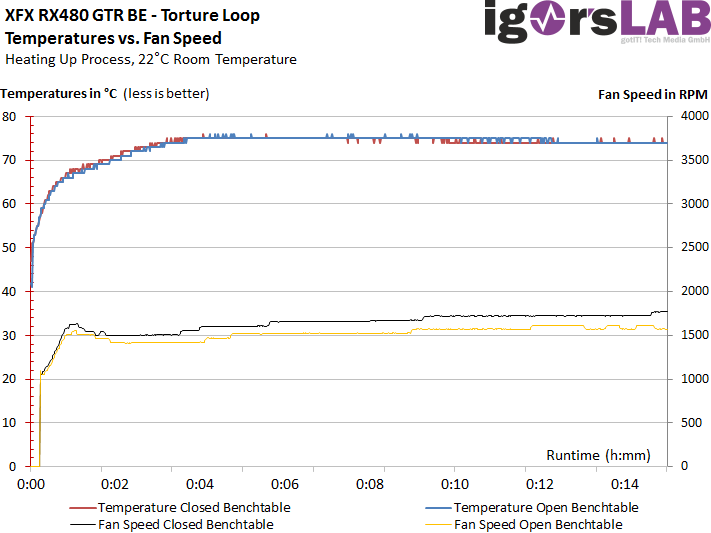 |
With up to 1750 rpm in the closed housing, these speeds are not so extremely high, although the approx. 1500 rpm in free construction are actually a good choice. Nevertheless, a slightly more aggressive curve could have ensured that the board remains significantly cooler, especially with the memory modules. It's a pity that some manufacturers just focus on the GPU and simply ignore the rest.
This also has a direct effect on the pressure level. The noise emission in gaming is just over 38 dB(A), which is not overly loud, but is still clearly audible. However, approx. 200 watts of waste heat are transported away, which puts this into perspective.
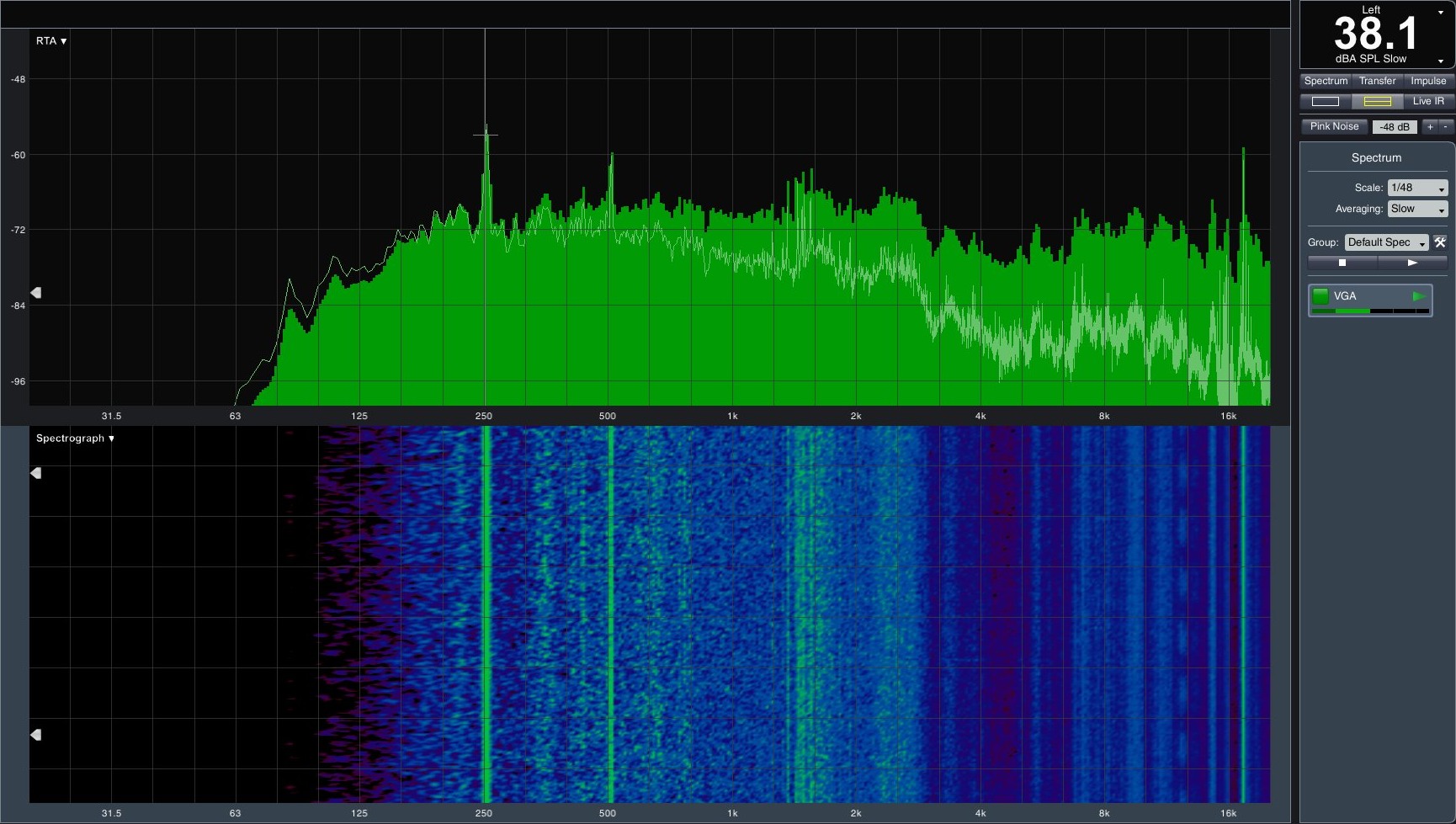
The sound spectrum is rather inconspicuous, with slightly lower-frequency bearing noises (approx. 250 Hz) and of course the fan noise (1.5 to 3 KHz) dominate somewhat. Measurable were also available at approx. 16 KHz higher frequency converter noises, which are then hardly or not perceived at all by the human ear.
6. Intermediate conclusion
The XFX RX480 GTR Black Edition itself is not a bad implementation of the Radeon RX480, but it definitely suffers from the inappropriate division of the voltage converter phases, which result in a more than 27% higher current flow at the mainboard slot than the PCI SIG as standard maximum Specified. The problem has been known since the launch of the reference card and it is therefore all the more surprising that one carelessly adds one more and tramples on existing specifications so much.
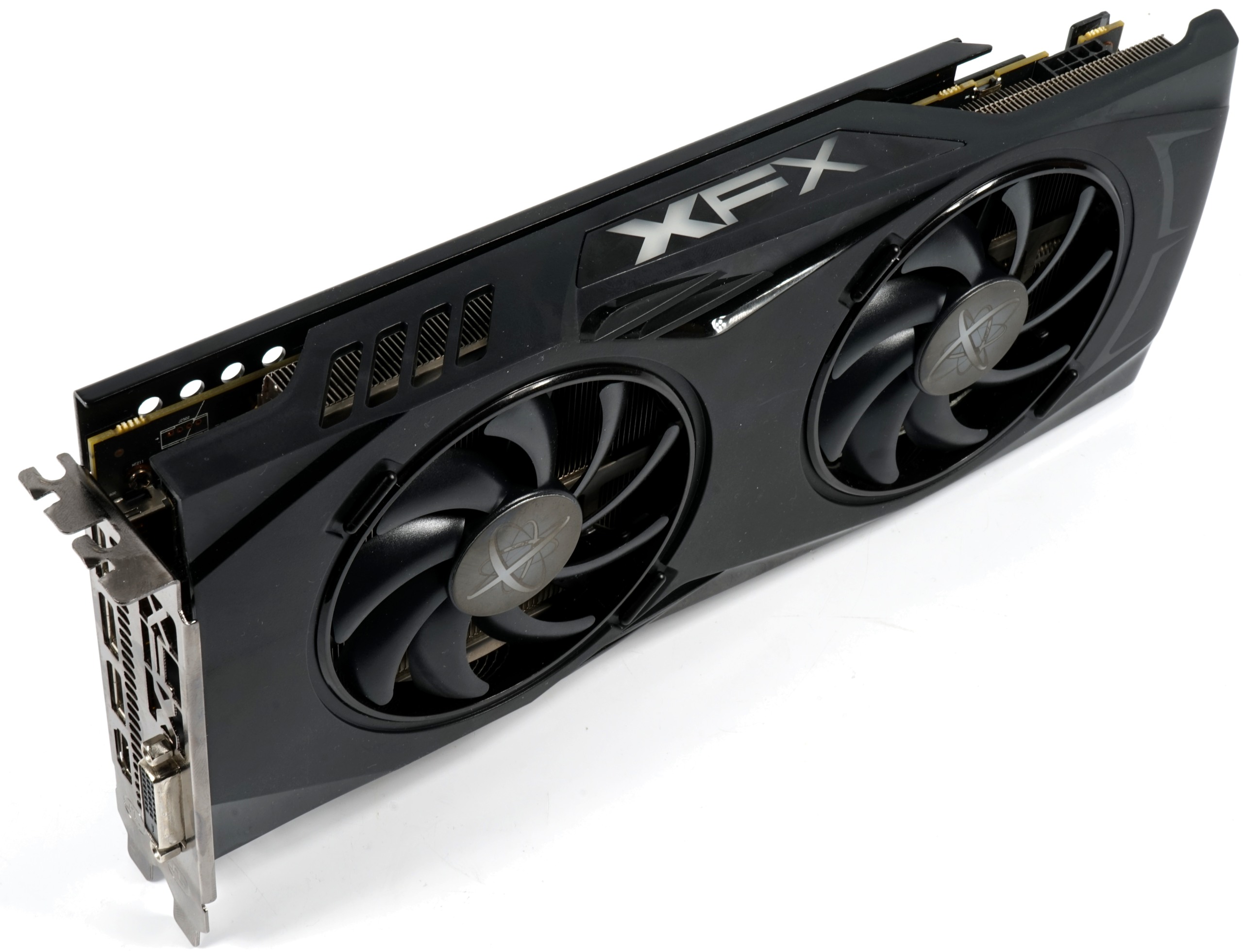
The cooling performance is acceptable, especially since the fans still act acoustically within tolerable framework. Even the very stable clock, which can be kept almost consistently, would actually be worth a recommendation, if it weren't for the annoyance with the permanent overload. The only thing that is a little too careless cooling of the board is the slightly too careless, which unnecessarily pushes the memory modules to the limits at the hottest point.
Therefore, we cannot recommend this card without restriction, but explicitly point out that when used, care must be taken that the motherboard used uses all four instead of the three standardized pins for the power supply. If you can't really make sure you do this, you'd better think twice or look for alternative cards right away.
- 1 - Einführung, Übersicht und Test-Setup
- 2 - AMD Radeon RX480 Reference
- 3 - Asus RX480 Strix
- 4 - HIS RX480 IceQ X² Roaring Turbo
- 5 - MSI RX480 Gaming X 8G
- 6 - Powercolor RX480 Red Devil
- 7 - Sapphire RX480 Nitro+
- 8 - XFX RX480 GTR Black Edition
- 9 - Übersicht: Gaming-Performance
- 10 - Übersicht: Temperatur, Lautstärke und Leistungsaufnahme
- 11 - Zusammenfassung und Fazit

































Kommentieren